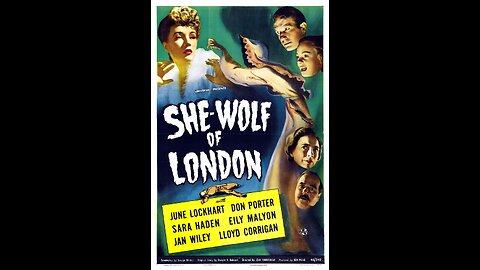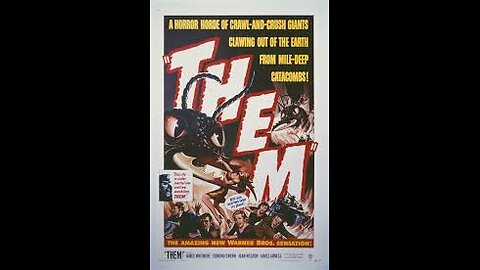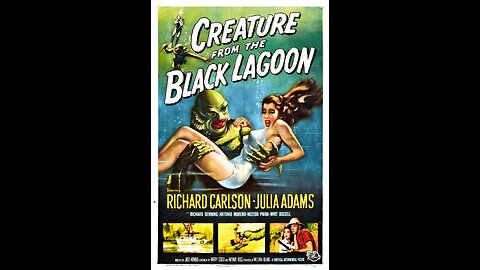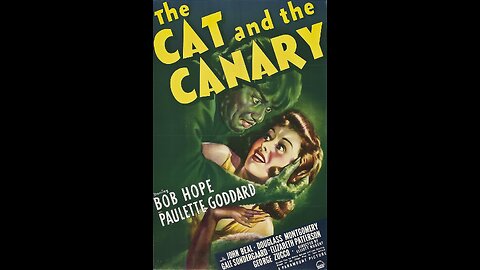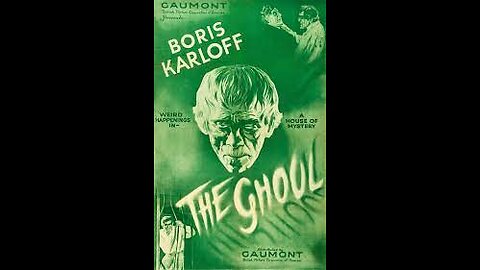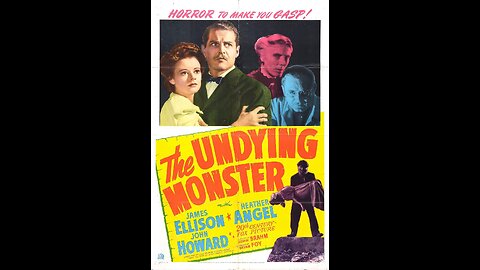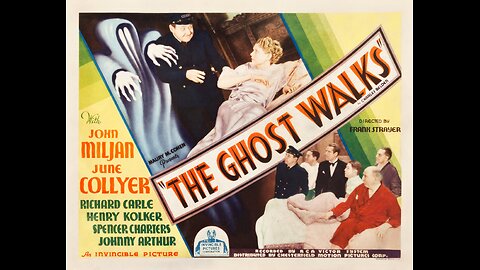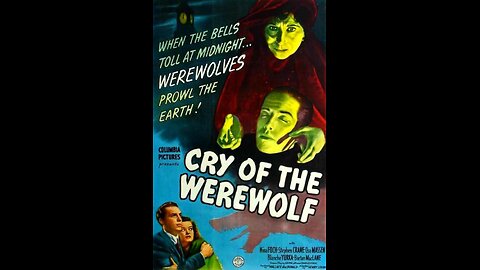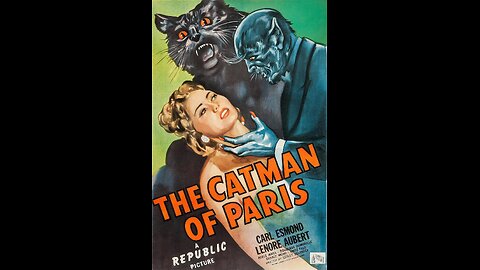
Horror Classics
19 videos
Updated 1 day ago
The Best Horror Movies from the Golden Age
-
The Catman of Paris (1946) | Directed by Lesley Selander
 Classic Films & Movies ArchiveThe Catman of Paris is a mystery-horror film set in 19th-century Paris. The story follows Charles Regnier, a successful author whose latest book has angered government officials. Upon his return to Paris, a series of gruesome murders occur, with victims clawed to death, leading to rumors of a feline-like killer. As suspicion falls on Regnier, he experiences blackouts and begins to question his own innocence. The film explores themes of identity, superstition, and the blurred lines between man and beast. Genre: Mystery, Horror Director: Lesley Selander Lesley Selander was an American film director known for his prolific work in the Western genre. Born in 1900, he directed over 100 films between the 1930s and 1960s. While Westerns were his primary focus, Selander occasionally ventured into other genres, including horror and adventure. His efficient directing style made him a reliable figure in Hollywood's B-movie industry. Star Cast: - Carl Esmond as Charles Regnier - Lenore Aubert as Marie Audet - Adele Mara as Marguerite Duval - Douglass Dumbrille as Henry Borchard - Gerald Mohr as Inspector Severen - Fritz Feld as Police Prefect Upon its release, The Catman of Paris received mixed reviews. Some audiences appreciated its atmospheric setting and the blend of mystery and horror elements. However, critics often pointed out the film's sluggish plot and lack of suspense. Over time, it has been viewed as a modest entry in Republic Pictures' catalog of 1940s horror films. Fun Facts: - The film was produced by Republic Pictures, known primarily for Westerns and serials, marking one of their few forays into the horror genre. - The production was completed in a short span, with filming starting on September 20 and concluding on October 10, 1945. - The Catman of Paris was intended to be part of a double feature alongside another horror film, Valley of the Zombies, as Republic Pictures' first horror double bill. - Despite its title, the film does not feature a traditional "catman" creature but rather centers on the psychological turmoil of the protagonist amid mysterious killings. * This Rumble Movie Channel is comprehensively indexed on https://kinoquick.com - find you favourite movies fast & free! Subscribe to this channel to be notified of daily movie updates.116 views
Classic Films & Movies ArchiveThe Catman of Paris is a mystery-horror film set in 19th-century Paris. The story follows Charles Regnier, a successful author whose latest book has angered government officials. Upon his return to Paris, a series of gruesome murders occur, with victims clawed to death, leading to rumors of a feline-like killer. As suspicion falls on Regnier, he experiences blackouts and begins to question his own innocence. The film explores themes of identity, superstition, and the blurred lines between man and beast. Genre: Mystery, Horror Director: Lesley Selander Lesley Selander was an American film director known for his prolific work in the Western genre. Born in 1900, he directed over 100 films between the 1930s and 1960s. While Westerns were his primary focus, Selander occasionally ventured into other genres, including horror and adventure. His efficient directing style made him a reliable figure in Hollywood's B-movie industry. Star Cast: - Carl Esmond as Charles Regnier - Lenore Aubert as Marie Audet - Adele Mara as Marguerite Duval - Douglass Dumbrille as Henry Borchard - Gerald Mohr as Inspector Severen - Fritz Feld as Police Prefect Upon its release, The Catman of Paris received mixed reviews. Some audiences appreciated its atmospheric setting and the blend of mystery and horror elements. However, critics often pointed out the film's sluggish plot and lack of suspense. Over time, it has been viewed as a modest entry in Republic Pictures' catalog of 1940s horror films. Fun Facts: - The film was produced by Republic Pictures, known primarily for Westerns and serials, marking one of their few forays into the horror genre. - The production was completed in a short span, with filming starting on September 20 and concluding on October 10, 1945. - The Catman of Paris was intended to be part of a double feature alongside another horror film, Valley of the Zombies, as Republic Pictures' first horror double bill. - Despite its title, the film does not feature a traditional "catman" creature but rather centers on the psychological turmoil of the protagonist amid mysterious killings. * This Rumble Movie Channel is comprehensively indexed on https://kinoquick.com - find you favourite movies fast & free! Subscribe to this channel to be notified of daily movie updates.116 views -
She-Wolf of London (1946) | Directed by Jean Yarbrough
 Classic Films & Movies ArchiveShe-Wolf of London is a psychological horror-mystery film that follows a young woman who fears she may be responsible for a series of gruesome murders. Phyllis Allenby, living in Victorian London, believes she is cursed by the legendary "Allenby Curse," which supposedly turns her into a murderous werewolf. As she experiences strange episodes and finds evidence of violent attacks near her home, paranoia and terror grip her. The film builds suspense as Phyllis questions her own sanity, leading to a shocking revelation about the true nature of the crimes. Genre: Horror, Mystery, Thriller Director: Jean Yarbrough Jean Yarbrough was an American film and television director known for his work in low-budget horror films, westerns, and comedies. Born in 1901, he directed numerous B-movies for Universal Pictures, including horror films such as House of Horrors (1946) and The Brute Man (1946). Later in his career, he transitioned to television, working on popular shows like The Abbott and Costello Show and The Adventures of Superman. Though not widely celebrated, he had a prolific career in genre film making. Star Cast: - June Lockhart as Phyllis Allenby - Don Porter as Barry Lanfield - Sara Haden as Martha Winthrop - Jan Wiley as Carol Winthrop - Eily Malyon as Hannah - Lloyd Corrigan as Detective Latham She-Wolf of London was met with mixed reviews upon its release. Some audiences were disappointed by the lack of supernatural horror, expecting a traditional werewolf film, only to discover that the story was more of a psychological thriller. However, critics appreciated its eerie atmosphere and strong performances, particularly from June Lockhart. Over time, the film has gained some recognition as a unique entry in Universal’s horror catalog, offering a different take on the werewolf mythos. Fun Facts: - Despite its title, the film does not actually feature a werewolf, making it an unusual entry in the werewolf film subgenre. - June Lockhart, best known for her later roles in Lassie and Lost in Space, plays the lead in one of her earliest major film performances. - The movie was produced as part of Universal’s B-horror films in the 1940s, which often had lower budgets but were still popular among horror fans. - The story draws inspiration from classic Gothic horror themes, such as family curses, psychological distress, and Victorian-era suspense. - The film was shot on a relatively small set, relying on fog and shadows to create its moody atmosphere. * This Rumble Movie Channel is comprehensively indexed on https://kinoquick.com - find you favourite movies fast & free! Subscribe to this channel to be notified of daily movie updates.163 views
Classic Films & Movies ArchiveShe-Wolf of London is a psychological horror-mystery film that follows a young woman who fears she may be responsible for a series of gruesome murders. Phyllis Allenby, living in Victorian London, believes she is cursed by the legendary "Allenby Curse," which supposedly turns her into a murderous werewolf. As she experiences strange episodes and finds evidence of violent attacks near her home, paranoia and terror grip her. The film builds suspense as Phyllis questions her own sanity, leading to a shocking revelation about the true nature of the crimes. Genre: Horror, Mystery, Thriller Director: Jean Yarbrough Jean Yarbrough was an American film and television director known for his work in low-budget horror films, westerns, and comedies. Born in 1901, he directed numerous B-movies for Universal Pictures, including horror films such as House of Horrors (1946) and The Brute Man (1946). Later in his career, he transitioned to television, working on popular shows like The Abbott and Costello Show and The Adventures of Superman. Though not widely celebrated, he had a prolific career in genre film making. Star Cast: - June Lockhart as Phyllis Allenby - Don Porter as Barry Lanfield - Sara Haden as Martha Winthrop - Jan Wiley as Carol Winthrop - Eily Malyon as Hannah - Lloyd Corrigan as Detective Latham She-Wolf of London was met with mixed reviews upon its release. Some audiences were disappointed by the lack of supernatural horror, expecting a traditional werewolf film, only to discover that the story was more of a psychological thriller. However, critics appreciated its eerie atmosphere and strong performances, particularly from June Lockhart. Over time, the film has gained some recognition as a unique entry in Universal’s horror catalog, offering a different take on the werewolf mythos. Fun Facts: - Despite its title, the film does not actually feature a werewolf, making it an unusual entry in the werewolf film subgenre. - June Lockhart, best known for her later roles in Lassie and Lost in Space, plays the lead in one of her earliest major film performances. - The movie was produced as part of Universal’s B-horror films in the 1940s, which often had lower budgets but were still popular among horror fans. - The story draws inspiration from classic Gothic horror themes, such as family curses, psychological distress, and Victorian-era suspense. - The film was shot on a relatively small set, relying on fog and shadows to create its moody atmosphere. * This Rumble Movie Channel is comprehensively indexed on https://kinoquick.com - find you favourite movies fast & free! Subscribe to this channel to be notified of daily movie updates.163 views -
Them! (1954) | Directed by Gordon Douglas
 Classic Films & Movies ArchiveIn the New Mexico desert, police sergeant Ben Peterson discovers a young girl in shock near a destroyed trailer. Investigations reveal that atomic tests have caused common ants to mutate into giant, aggressive creatures threatening humanity. As the ants spread, authorities race against time to locate and exterminate the colonies before they overrun civilization. Genre: Science Fiction, Horror Director: Gordon Douglas Gordon Douglas (1907–1993) was an American film director known for his versatility across various genres, including westerns, crime dramas, and science fiction. His career spanned several decades, during which he directed notable films such as "The Detective" (1968) and "Stagecoach" (1966). Star Cast: - James Whitmore as Sgt. Ben Peterson - Edmund Gwenn as Dr. Harold Medford - Joan Weldon as Dr. Patricia Medford - James Arness as FBI Agent Robert Graham - Onslow Stevens as General O'Brien - Sean McClory as Major Kibbee - Chris Drake as Trooper Ed Blackburn - Sandy Descher as Ellinson Girl - Fess Parker as Alan Crotty - Olin Howland as Jensen (uncredited) Upon its release, "Them!" was praised for its suspenseful narrative and special effects, earning an Academy Award nomination for Best Special Effects. It has since become a classic in the science fiction genre, noted for its commentary on the fears surrounding nuclear technology in the 1950s. Fun Facts: - "Them!" was originally planned to be filmed in color and 3D; however, due to technical issues, it was shot in black and white. - The film is one of the first "nuclear monster" movies, initiating a trend of science fiction films featuring creatures mutated by atomic radiation. - A young Leonard Nimoy makes an uncredited appearance as an Air Force sergeant, years before gaining fame as Spock in "Star Trek."225 views
Classic Films & Movies ArchiveIn the New Mexico desert, police sergeant Ben Peterson discovers a young girl in shock near a destroyed trailer. Investigations reveal that atomic tests have caused common ants to mutate into giant, aggressive creatures threatening humanity. As the ants spread, authorities race against time to locate and exterminate the colonies before they overrun civilization. Genre: Science Fiction, Horror Director: Gordon Douglas Gordon Douglas (1907–1993) was an American film director known for his versatility across various genres, including westerns, crime dramas, and science fiction. His career spanned several decades, during which he directed notable films such as "The Detective" (1968) and "Stagecoach" (1966). Star Cast: - James Whitmore as Sgt. Ben Peterson - Edmund Gwenn as Dr. Harold Medford - Joan Weldon as Dr. Patricia Medford - James Arness as FBI Agent Robert Graham - Onslow Stevens as General O'Brien - Sean McClory as Major Kibbee - Chris Drake as Trooper Ed Blackburn - Sandy Descher as Ellinson Girl - Fess Parker as Alan Crotty - Olin Howland as Jensen (uncredited) Upon its release, "Them!" was praised for its suspenseful narrative and special effects, earning an Academy Award nomination for Best Special Effects. It has since become a classic in the science fiction genre, noted for its commentary on the fears surrounding nuclear technology in the 1950s. Fun Facts: - "Them!" was originally planned to be filmed in color and 3D; however, due to technical issues, it was shot in black and white. - The film is one of the first "nuclear monster" movies, initiating a trend of science fiction films featuring creatures mutated by atomic radiation. - A young Leonard Nimoy makes an uncredited appearance as an Air Force sergeant, years before gaining fame as Spock in "Star Trek."225 views -
Creature from the Black Lagoon (1954) | Directed by Jack Arnold
 Classic Films & Movies Archive"Creature from the Black Lagoon" is a 1954 American science fiction horror film directed by Jack Arnold. The story centers on an Amazonian expedition that uncovers a prehistoric, amphibious humanoid known as the Gill-man. As the team attempts to study and capture the creature, tensions rise, leading to a series of suspenseful and dangerous encounters. Genre: Science Fiction / Horror Director: Jack Arnold Jack Arnold (1916–1992) was an American film and television director renowned for his contributions to 1950s science fiction cinema. Born in New Haven, Connecticut, Arnold initially pursued acting before transitioning to directing. He gained prominence with films like "It Came from Outer Space" (1953) and "The Incredible Shrinking Man" (1957), noted for their atmospheric storytelling and innovative special effects. Arnold's work has left a lasting impact on the science fiction genre. Star Cast: - Richard Carlson as Dr. David Reed, the expedition's ichthyologist. - Julie Adams as Kay Lawrence, Dr. Reed's colleague and romantic interest. - Richard Denning as Dr. Mark Williams, a scientist driven by ambition. - Antonio Moreno as Dr. Carl Maia, the discoverer of the fossilized creature. - Nestor Paiva as Captain Lucas, the steamboat captain navigating the Amazon. Upon its release, "Creature from the Black Lagoon" captivated audiences with its suspenseful narrative and groundbreaking creature design. The film's 3D presentation added to its immersive experience, contributing to its success at the box office. Over time, it has achieved cult classic status, influencing numerous filmmakers and spawning sequels. Critics have lauded its atmospheric tension and the iconic portrayal of the Gill-man. Fun Facts: 1. The Gill-man was portrayed by two actors: Ben Chapman for land scenes and Ricou Browning for underwater sequences. Browning, an accomplished diver, performed the underwater scenes filmed in Florida. 2. The film was originally released in 3D during the 1950s' 3D movie craze, enhancing its immersive horror elements. 3. Milicent Patrick, a Disney animator, designed the iconic creature, though her contributions were downplayed for decades. Recent acknowledgments have credited her for the creature's memorable appearance. 4. The underwater scenes were filmed at Wakulla Springs in Florida, chosen for its crystal-clear waters that provided optimal visibility for filming. 5. The film's success led to two sequels: "Revenge of the Creature" (1955), which featured a young Clint Eastwood in his film debut, and "The Creature Walks Among Us" (1956). "Creature from the Black Lagoon" remains a seminal work in the science fiction and horror genres, celebrated for its innovative effects, compelling narrative, and the enduring legacy of its titular creature.166 views 1 comment
Classic Films & Movies Archive"Creature from the Black Lagoon" is a 1954 American science fiction horror film directed by Jack Arnold. The story centers on an Amazonian expedition that uncovers a prehistoric, amphibious humanoid known as the Gill-man. As the team attempts to study and capture the creature, tensions rise, leading to a series of suspenseful and dangerous encounters. Genre: Science Fiction / Horror Director: Jack Arnold Jack Arnold (1916–1992) was an American film and television director renowned for his contributions to 1950s science fiction cinema. Born in New Haven, Connecticut, Arnold initially pursued acting before transitioning to directing. He gained prominence with films like "It Came from Outer Space" (1953) and "The Incredible Shrinking Man" (1957), noted for their atmospheric storytelling and innovative special effects. Arnold's work has left a lasting impact on the science fiction genre. Star Cast: - Richard Carlson as Dr. David Reed, the expedition's ichthyologist. - Julie Adams as Kay Lawrence, Dr. Reed's colleague and romantic interest. - Richard Denning as Dr. Mark Williams, a scientist driven by ambition. - Antonio Moreno as Dr. Carl Maia, the discoverer of the fossilized creature. - Nestor Paiva as Captain Lucas, the steamboat captain navigating the Amazon. Upon its release, "Creature from the Black Lagoon" captivated audiences with its suspenseful narrative and groundbreaking creature design. The film's 3D presentation added to its immersive experience, contributing to its success at the box office. Over time, it has achieved cult classic status, influencing numerous filmmakers and spawning sequels. Critics have lauded its atmospheric tension and the iconic portrayal of the Gill-man. Fun Facts: 1. The Gill-man was portrayed by two actors: Ben Chapman for land scenes and Ricou Browning for underwater sequences. Browning, an accomplished diver, performed the underwater scenes filmed in Florida. 2. The film was originally released in 3D during the 1950s' 3D movie craze, enhancing its immersive horror elements. 3. Milicent Patrick, a Disney animator, designed the iconic creature, though her contributions were downplayed for decades. Recent acknowledgments have credited her for the creature's memorable appearance. 4. The underwater scenes were filmed at Wakulla Springs in Florida, chosen for its crystal-clear waters that provided optimal visibility for filming. 5. The film's success led to two sequels: "Revenge of the Creature" (1955), which featured a young Clint Eastwood in his film debut, and "The Creature Walks Among Us" (1956). "Creature from the Black Lagoon" remains a seminal work in the science fiction and horror genres, celebrated for its innovative effects, compelling narrative, and the enduring legacy of its titular creature.166 views 1 comment -
Dr. Renault's Secret (1942) | A horror-mystery film directed by Harry Lachman.
 Classic Films & Movies Archive"Dr. Renault's Secret" is a horror-mystery film released in 1942, directed by Harry Lachman. The film is part of the horror genre with elements of suspense, featuring a story centered around a mysterious doctor and the eerie secrets hidden within his mansion. The film stars J. Carrol Naish, Shepperd Strudwick, and Lynne Roberts. The narrative unfolds in a small French village where Dr. Larry Forbes (Shepperd Strudwick) arrives to take over the practice of a retiring physician. However, he soon becomes entangled in a web of mystery surrounding the enigmatic Dr. Renault (J. Carrol Naish), the previous doctor. As Dr. Forbes delves into his new responsibilities, he discovers strange occurrences and peculiar behavior within Dr. Renault's mansion. The mystery deepens when he encounters a series of suspicious characters, including the beautiful and troubled Madelon (Lynne Roberts) and the sinister Noel (George Zucco). Dr. Forbes becomes increasingly curious about Dr. Renault's past and the dark secrets lurking within the old mansion. J. Carrol Naish delivers a memorable performance as the secretive Dr. Renault, adding an air of mystery and ambiguity to the character. Shepperd Strudwick's portrayal of the inquisitive Dr. Forbes captures the growing sense of unease and curiosity that permeates the film. The film incorporates elements of Gothic horror, including a foreboding mansion, secret passages, and a sense of isolation. The atmospheric cinematography, likely influenced by the noir aesthetic, contributes to the film's moody and mysterious ambiance. As Dr. Forbes unravels the secrets surrounding Dr. Renault, the plot takes unexpected turns, building suspense and tension. The film explores themes of morality, guilt, and the consequences of hidden transgressions. "Dr. Renault's Secret" is characteristic of the horror films produced during the 1940s, offering a blend of mystery, suspense, and Gothic atmosphere. While it may not be as widely remembered as some other films of the era, it remains a notable entry in the horror genre, showcasing the talents of its cast and the atmospheric storytelling common to classic horror films.106 views
Classic Films & Movies Archive"Dr. Renault's Secret" is a horror-mystery film released in 1942, directed by Harry Lachman. The film is part of the horror genre with elements of suspense, featuring a story centered around a mysterious doctor and the eerie secrets hidden within his mansion. The film stars J. Carrol Naish, Shepperd Strudwick, and Lynne Roberts. The narrative unfolds in a small French village where Dr. Larry Forbes (Shepperd Strudwick) arrives to take over the practice of a retiring physician. However, he soon becomes entangled in a web of mystery surrounding the enigmatic Dr. Renault (J. Carrol Naish), the previous doctor. As Dr. Forbes delves into his new responsibilities, he discovers strange occurrences and peculiar behavior within Dr. Renault's mansion. The mystery deepens when he encounters a series of suspicious characters, including the beautiful and troubled Madelon (Lynne Roberts) and the sinister Noel (George Zucco). Dr. Forbes becomes increasingly curious about Dr. Renault's past and the dark secrets lurking within the old mansion. J. Carrol Naish delivers a memorable performance as the secretive Dr. Renault, adding an air of mystery and ambiguity to the character. Shepperd Strudwick's portrayal of the inquisitive Dr. Forbes captures the growing sense of unease and curiosity that permeates the film. The film incorporates elements of Gothic horror, including a foreboding mansion, secret passages, and a sense of isolation. The atmospheric cinematography, likely influenced by the noir aesthetic, contributes to the film's moody and mysterious ambiance. As Dr. Forbes unravels the secrets surrounding Dr. Renault, the plot takes unexpected turns, building suspense and tension. The film explores themes of morality, guilt, and the consequences of hidden transgressions. "Dr. Renault's Secret" is characteristic of the horror films produced during the 1940s, offering a blend of mystery, suspense, and Gothic atmosphere. While it may not be as widely remembered as some other films of the era, it remains a notable entry in the horror genre, showcasing the talents of its cast and the atmospheric storytelling common to classic horror films.106 views -
The Cat and the Canary (1939) | classic American horror-comedy film directed by Elliott Nugent
 Classic Films & Movies Archive"The Cat and the Canary" is a classic American horror-comedy film directed by Elliott Nugent. It was released in 1939 and is a remake of the 1927 silent film of the same name. The movie is based on the 1922 play by John Willard. This 1939 version stars Bob Hope, Paulette Goddard, and John Beal. The story revolves around the death of Cyrus West, a wealthy eccentric who, before his passing, had set up a will to be read 20 years after his death. The inheritance is to be given to one of his surviving relatives, but there's a catch: the potential heirs must spend the night in his creepy, isolated mansion to claim their share of the fortune. If they don't, the money will go to someone else. Bob Hope plays the character of Wally Campbell, a wisecracking radio personality who finds himself in the midst of the eerie and mysterious night at the mansion. Paulette Goddard portrays Joyce Norman, a young woman with a claim to the inheritance. The rest of the cast includes various relatives and characters, each with their own motives and quirks. As the night progresses, the characters begin to experience strange occurrences and frightening events within the mansion. The film masterfully combines elements of suspense and humor, with Bob Hope's comedic timing adding a lighthearted touch to the spooky atmosphere. "The Cat and the Canary" is known for its blend of horror and comedy, a style often associated with director Elliott Nugent and actor Bob Hope. The movie features a classic "old dark house" setting, with secret passages, hidden doors, and spooky elements that contribute to the suspense. The film's success lies not only in its ability to create tension and scares but also in its ability to balance these moments with humor. Overall, "The Cat and the Canary" (1939) is a delightful and entertaining classic that showcases the talents of its cast, especially Bob Hope, in delivering both chills and laughs. The film has retained its popularity over the years, solidifying its place in the history of classic horror-comedy cinema.269 views
Classic Films & Movies Archive"The Cat and the Canary" is a classic American horror-comedy film directed by Elliott Nugent. It was released in 1939 and is a remake of the 1927 silent film of the same name. The movie is based on the 1922 play by John Willard. This 1939 version stars Bob Hope, Paulette Goddard, and John Beal. The story revolves around the death of Cyrus West, a wealthy eccentric who, before his passing, had set up a will to be read 20 years after his death. The inheritance is to be given to one of his surviving relatives, but there's a catch: the potential heirs must spend the night in his creepy, isolated mansion to claim their share of the fortune. If they don't, the money will go to someone else. Bob Hope plays the character of Wally Campbell, a wisecracking radio personality who finds himself in the midst of the eerie and mysterious night at the mansion. Paulette Goddard portrays Joyce Norman, a young woman with a claim to the inheritance. The rest of the cast includes various relatives and characters, each with their own motives and quirks. As the night progresses, the characters begin to experience strange occurrences and frightening events within the mansion. The film masterfully combines elements of suspense and humor, with Bob Hope's comedic timing adding a lighthearted touch to the spooky atmosphere. "The Cat and the Canary" is known for its blend of horror and comedy, a style often associated with director Elliott Nugent and actor Bob Hope. The movie features a classic "old dark house" setting, with secret passages, hidden doors, and spooky elements that contribute to the suspense. The film's success lies not only in its ability to create tension and scares but also in its ability to balance these moments with humor. Overall, "The Cat and the Canary" (1939) is a delightful and entertaining classic that showcases the talents of its cast, especially Bob Hope, in delivering both chills and laughs. The film has retained its popularity over the years, solidifying its place in the history of classic horror-comedy cinema.269 views -
The Ghoul (1933) | British horror film directed by T. Hayes Hunter
 Classic Films & Movies Archive"The Ghoul" is a British horror film released in 1933, directed by T. Hayes Hunter. The film is notable for being one of Boris Karloff's early starring roles in a horror film. "The Ghoul" is considered a classic of early British horror cinema, and it features elements of both horror and mystery genres. The story revolves around Professor Morlant (Boris Karloff), an Egyptologist who is fascinated by the idea of immortality. Before his death, Morlant instructs his servant, Laing (Ernest Thesiger), to bury him with a valuable gem known as the Eternal Light. Morlant believes that this gem has the power to grant him eternal life. After Morlant's death, a group of people, including his lawyer (Cedric Hardwicke), a relative (Kathleen Harrison), and an acquaintance (Harold Huth), gather at his mansion for the reading of his will. As the events unfold, it becomes apparent that Morlant's obsession with immortality has left a sinister mark on those connected to him. The story takes a dark turn when it is revealed that Morlant has risen from the dead and is now seeking both the gem and a victim whose heart's blood will allow him to achieve true immortality. The film unfolds as a combination of a mystery and a horror story, with elements of supernatural and Gothic horror blended into the narrative. "The Ghoul" is praised for its atmospheric and eerie tone, capturing the essence of early 1930s horror cinema. Boris Karloff's performance as Professor Morlant is a standout, as he brings a brooding and otherworldly presence to the character. The film benefits from its moody cinematography and effective use of shadows and lighting to create a sense of foreboding. The plot, while containing some traditional horror elements, also incorporates mystery elements, keeping the audience engaged as they unravel the secrets surrounding Morlant's obsession and the curse that follows. The pacing is deliberate, allowing for the tension to build gradually. The supporting cast, including notable actors like Ernest Thesiger and Cedric Hardwicke, contributes to the film's overall quality. Thesiger, in particular, is known for his ability to portray eccentric and memorable characters, and his role as the loyal butler Laing adds depth to the story. "The Ghoul" is often celebrated for its influence on later horror films and for showcasing Boris Karloff in a role that further solidified his status as a horror icon. While it may not have achieved the same level of fame as some of Karloff's other works, "The Ghoul" remains a significant and atmospheric entry in the early history of British horror cinema. It's appreciated by fans of classic horror for its eerie atmosphere, strong performances, and contributions to the genre's development during the 1930s.100 views 1 comment
Classic Films & Movies Archive"The Ghoul" is a British horror film released in 1933, directed by T. Hayes Hunter. The film is notable for being one of Boris Karloff's early starring roles in a horror film. "The Ghoul" is considered a classic of early British horror cinema, and it features elements of both horror and mystery genres. The story revolves around Professor Morlant (Boris Karloff), an Egyptologist who is fascinated by the idea of immortality. Before his death, Morlant instructs his servant, Laing (Ernest Thesiger), to bury him with a valuable gem known as the Eternal Light. Morlant believes that this gem has the power to grant him eternal life. After Morlant's death, a group of people, including his lawyer (Cedric Hardwicke), a relative (Kathleen Harrison), and an acquaintance (Harold Huth), gather at his mansion for the reading of his will. As the events unfold, it becomes apparent that Morlant's obsession with immortality has left a sinister mark on those connected to him. The story takes a dark turn when it is revealed that Morlant has risen from the dead and is now seeking both the gem and a victim whose heart's blood will allow him to achieve true immortality. The film unfolds as a combination of a mystery and a horror story, with elements of supernatural and Gothic horror blended into the narrative. "The Ghoul" is praised for its atmospheric and eerie tone, capturing the essence of early 1930s horror cinema. Boris Karloff's performance as Professor Morlant is a standout, as he brings a brooding and otherworldly presence to the character. The film benefits from its moody cinematography and effective use of shadows and lighting to create a sense of foreboding. The plot, while containing some traditional horror elements, also incorporates mystery elements, keeping the audience engaged as they unravel the secrets surrounding Morlant's obsession and the curse that follows. The pacing is deliberate, allowing for the tension to build gradually. The supporting cast, including notable actors like Ernest Thesiger and Cedric Hardwicke, contributes to the film's overall quality. Thesiger, in particular, is known for his ability to portray eccentric and memorable characters, and his role as the loyal butler Laing adds depth to the story. "The Ghoul" is often celebrated for its influence on later horror films and for showcasing Boris Karloff in a role that further solidified his status as a horror icon. While it may not have achieved the same level of fame as some of Karloff's other works, "The Ghoul" remains a significant and atmospheric entry in the early history of British horror cinema. It's appreciated by fans of classic horror for its eerie atmosphere, strong performances, and contributions to the genre's development during the 1930s.100 views 1 comment -
The Undying Monster (1942) | American horror film directed by John Brahm
 Classic Films & Movies Archive"The Undying Monster" is a 1942 American horror film directed by John Brahm. The film is based on the novel of the same name by Jessie Douglas Kerruish and falls within the realm of classic Gothic horror. The film opens with the Hammond family, British aristocrats residing in a centuries-old manor named Hammond Hall. The family is cursed by a mysterious and malevolent force that seems to be responsible for a series of gruesome deaths that have haunted the family for generations. When the latest Hammond, Oliver Hammond (played by John Howard), is killed under mysterious circumstances, Scotland Yard is called in to investigate. Dr. Jeff Colbert (played by James Ellison), a renowned forensic scientist, and his sister Helga (played by Heather Angel) become involved in the case. As the investigation unfolds, Dr. Colbert becomes intrigued by the possibility that a supernatural force might be at play. The local legend speaks of a "werewolf" that is said to be the cause of the Hammond family curse. Dr. Colbert and Helga delve into the family's dark history, uncovering secrets and hidden truths. The film builds an atmosphere of suspense and mystery as the characters navigate the eerie halls of Hammond Hall. The enigmatic and brooding presence of the family's matriarch, Mrs. Hammond (played by Fay Helm), adds to the sense of foreboding. As the investigation progresses, the possibility of a supernatural force becomes more tangible. Dr. Colbert employs scientific methods to understand the nature of the curse, while Helga explores the family archives and ancient legends for clues. The tension rises as they get closer to unraveling the truth behind the undying monster that plagues the Hammond family. The film skillfully blends elements of classic horror with Gothic romance, creating a mysterious and atmospheric narrative. The shadowy cinematography and moody set design contribute to the film's eerie ambiance. James Ellison (Dr. Jeff Colbert): Ellison delivers a solid performance as the scientist determined to uncover the truth behind the Hammond family curse. Heather Angel (Helga Colbert): Angel adds a sense of curiosity and determination to her role as Dr. Colbert's sister. "The Undying Monster" is recognized as a classic of the Gothic horror genre. While it may not be as widely known as some other films from the era, its atmospheric storytelling, mysterious plot, and nod to supernatural folklore contribute to its appeal among fans of classic horror cinema. The film remains a notable entry in the rich tapestry of Gothic horror films produced during the early decades of Hollywood.161 views
Classic Films & Movies Archive"The Undying Monster" is a 1942 American horror film directed by John Brahm. The film is based on the novel of the same name by Jessie Douglas Kerruish and falls within the realm of classic Gothic horror. The film opens with the Hammond family, British aristocrats residing in a centuries-old manor named Hammond Hall. The family is cursed by a mysterious and malevolent force that seems to be responsible for a series of gruesome deaths that have haunted the family for generations. When the latest Hammond, Oliver Hammond (played by John Howard), is killed under mysterious circumstances, Scotland Yard is called in to investigate. Dr. Jeff Colbert (played by James Ellison), a renowned forensic scientist, and his sister Helga (played by Heather Angel) become involved in the case. As the investigation unfolds, Dr. Colbert becomes intrigued by the possibility that a supernatural force might be at play. The local legend speaks of a "werewolf" that is said to be the cause of the Hammond family curse. Dr. Colbert and Helga delve into the family's dark history, uncovering secrets and hidden truths. The film builds an atmosphere of suspense and mystery as the characters navigate the eerie halls of Hammond Hall. The enigmatic and brooding presence of the family's matriarch, Mrs. Hammond (played by Fay Helm), adds to the sense of foreboding. As the investigation progresses, the possibility of a supernatural force becomes more tangible. Dr. Colbert employs scientific methods to understand the nature of the curse, while Helga explores the family archives and ancient legends for clues. The tension rises as they get closer to unraveling the truth behind the undying monster that plagues the Hammond family. The film skillfully blends elements of classic horror with Gothic romance, creating a mysterious and atmospheric narrative. The shadowy cinematography and moody set design contribute to the film's eerie ambiance. James Ellison (Dr. Jeff Colbert): Ellison delivers a solid performance as the scientist determined to uncover the truth behind the Hammond family curse. Heather Angel (Helga Colbert): Angel adds a sense of curiosity and determination to her role as Dr. Colbert's sister. "The Undying Monster" is recognized as a classic of the Gothic horror genre. While it may not be as widely known as some other films from the era, its atmospheric storytelling, mysterious plot, and nod to supernatural folklore contribute to its appeal among fans of classic horror cinema. The film remains a notable entry in the rich tapestry of Gothic horror films produced during the early decades of Hollywood.161 views -
The Ghost Walks (1934) | American horror-mystery film directed by Frank R. Strayer
 Classic Films & Movies Archive"The Ghost Walks" is a 1934 American horror-mystery film directed by Frank R. Strayer. It falls within the genre of old-fashioned, atmospheric horror with elements of mystery and suspense. The film unfolds in a classic, eerie setting—a stormy night in a remote mansion. Playwright John Spencer (played by John Miljan) has gathered a group of people at his mansion for the reading of his latest play. As the storm intensifies, the group finds themselves isolated in the mansion, setting the stage for mystery and suspense. Unexpectedly, the lights go out, and the group is plunged into darkness. When the lights return, one of the characters is found dead. The situation becomes even more mysterious when they discover that the deceased had predicted his own demise in a letter. As the characters attempt to unravel the mystery, suspicions arise among them. The plot thickens with the appearance of a mysterious stranger, a detective named Carl Beldon (played by Richard Carle), who adds an additional layer of intrigue. The detective is skeptical about the supernatural explanations suggested by the characters and believes there's a more rational explanation for the death. The film employs classic horror and mystery tropes, including secret passages, hidden compartments, and suspicious characters. The characters are trapped in the mansion, and tensions rise as they try to uncover the truth behind the death and the ominous presence that seems to haunt the house. As the narrative unfolds, the film keeps the audience guessing about the identity of the killer and the motives behind the mysterious events. The stormy night, creaky doors, and flickering candlelight contribute to the atmospheric and spooky ambiance. John Miljan (John Spencer): Miljan leads the cast as the playwright whose gathering takes a sinister turn. June Collyer: Collyer plays a key role in the film, contributing to the suspense and mystery as the events unfold. "The Ghost Walks" is a product of the atmospheric horror-mystery films that were popular in the 1930s. While it may not be as widely remembered as some other classics of the genre, it remains a representation of the kind of spooky and mysterious storytelling that captivated audiences during that era. The film's reliance on mood, suspense, and a classic whodunit structure makes it an interesting watch for fans of vintage horror films.83 views
Classic Films & Movies Archive"The Ghost Walks" is a 1934 American horror-mystery film directed by Frank R. Strayer. It falls within the genre of old-fashioned, atmospheric horror with elements of mystery and suspense. The film unfolds in a classic, eerie setting—a stormy night in a remote mansion. Playwright John Spencer (played by John Miljan) has gathered a group of people at his mansion for the reading of his latest play. As the storm intensifies, the group finds themselves isolated in the mansion, setting the stage for mystery and suspense. Unexpectedly, the lights go out, and the group is plunged into darkness. When the lights return, one of the characters is found dead. The situation becomes even more mysterious when they discover that the deceased had predicted his own demise in a letter. As the characters attempt to unravel the mystery, suspicions arise among them. The plot thickens with the appearance of a mysterious stranger, a detective named Carl Beldon (played by Richard Carle), who adds an additional layer of intrigue. The detective is skeptical about the supernatural explanations suggested by the characters and believes there's a more rational explanation for the death. The film employs classic horror and mystery tropes, including secret passages, hidden compartments, and suspicious characters. The characters are trapped in the mansion, and tensions rise as they try to uncover the truth behind the death and the ominous presence that seems to haunt the house. As the narrative unfolds, the film keeps the audience guessing about the identity of the killer and the motives behind the mysterious events. The stormy night, creaky doors, and flickering candlelight contribute to the atmospheric and spooky ambiance. John Miljan (John Spencer): Miljan leads the cast as the playwright whose gathering takes a sinister turn. June Collyer: Collyer plays a key role in the film, contributing to the suspense and mystery as the events unfold. "The Ghost Walks" is a product of the atmospheric horror-mystery films that were popular in the 1930s. While it may not be as widely remembered as some other classics of the genre, it remains a representation of the kind of spooky and mysterious storytelling that captivated audiences during that era. The film's reliance on mood, suspense, and a classic whodunit structure makes it an interesting watch for fans of vintage horror films.83 views -
Cry of the Werewolf (1944) | Directed by Henry Levin
 Classic Films & Movies ArchiveCry of the Werewolf is a horror-mystery film that follows the eerie investigation of a series of murders linked to a mysterious gypsy curse. When a scientist researching supernatural folklore is found dead, his son Paul and a detective begin to uncover the dark secrets of a local Romani tribe, led by the beautiful yet deadly Princess Celeste. As they delve deeper, they realize that Celeste herself may be the source of the killings—able to transform into a werewolf under the light of the full moon. Combining elements of noir, folklore, and classic horror, the film presents an atmospheric tale of terror and suspense. Genre: Horror, Mystery, Thriller Director: Henry Levin Henry Levin was an American director known for his work in a variety of genres, including adventure, comedy, and science fiction. Starting in the 1940s, he directed a mix of B-movies and big-budget productions, eventually earning recognition for films like Journey to the Center of the Earth (1959). Levin’s ability to create tension and intrigue in his films, even on a limited budget, made him a reliable filmmaker in Hollywood’s golden age. Star Cast: - Nina Foch as Princess Celeste - Stephen Crane as Robert Baldwin - Osa Massen as Elsa Chauvet - Blanche Yurka as Madame Petrova - Barton MacLane as Detective Lt. Barry Lane Cry of the Werewolf was a lesser-known entry in the 1940s horror genre, overshadowed by Universal’s more famous werewolf films. However, it was notable for featuring a female werewolf at a time when most cinematic werewolf stories centered around male protagonists. The film was praised for its eerie atmosphere, use of shadows, and Nina Foch’s haunting performance as Princess Celeste. Critics noted its budget constraints and lack of transformation effects, which relied more on suggestion than on-screen visuals. While not a major box office success, it has since gained a following among classic horror enthusiasts. Fun Facts: - Unlike many werewolf films of the era, Cry of the Werewolf avoided elaborate transformation sequences, relying on lighting and editing to suggest Celeste’s deadly metamorphosis. - Nina Foch, who played Princess Celeste, later became a respected acting coach and appeared in major films like An American in Paris (1951) and Spartacus (1960). - The film drew inspiration from Romani folklore, a rarity at the time, though its portrayal was influenced by Hollywood’s romanticized and often inaccurate depictions of Romani culture. - The story blends horror with detective fiction, making it one of the earlier examples of supernatural noir. - Though it wasn’t part of Universal’s iconic werewolf series, Cry of the Werewolf is often compared to films like The Wolf Man (1941) due to its gothic themes and suspenseful storytelling. 🎬 Instantly Find Your Favorite Movies! This Rumble movie channel is fully indexed at 👉 https://kinoquick.com212 views
Classic Films & Movies ArchiveCry of the Werewolf is a horror-mystery film that follows the eerie investigation of a series of murders linked to a mysterious gypsy curse. When a scientist researching supernatural folklore is found dead, his son Paul and a detective begin to uncover the dark secrets of a local Romani tribe, led by the beautiful yet deadly Princess Celeste. As they delve deeper, they realize that Celeste herself may be the source of the killings—able to transform into a werewolf under the light of the full moon. Combining elements of noir, folklore, and classic horror, the film presents an atmospheric tale of terror and suspense. Genre: Horror, Mystery, Thriller Director: Henry Levin Henry Levin was an American director known for his work in a variety of genres, including adventure, comedy, and science fiction. Starting in the 1940s, he directed a mix of B-movies and big-budget productions, eventually earning recognition for films like Journey to the Center of the Earth (1959). Levin’s ability to create tension and intrigue in his films, even on a limited budget, made him a reliable filmmaker in Hollywood’s golden age. Star Cast: - Nina Foch as Princess Celeste - Stephen Crane as Robert Baldwin - Osa Massen as Elsa Chauvet - Blanche Yurka as Madame Petrova - Barton MacLane as Detective Lt. Barry Lane Cry of the Werewolf was a lesser-known entry in the 1940s horror genre, overshadowed by Universal’s more famous werewolf films. However, it was notable for featuring a female werewolf at a time when most cinematic werewolf stories centered around male protagonists. The film was praised for its eerie atmosphere, use of shadows, and Nina Foch’s haunting performance as Princess Celeste. Critics noted its budget constraints and lack of transformation effects, which relied more on suggestion than on-screen visuals. While not a major box office success, it has since gained a following among classic horror enthusiasts. Fun Facts: - Unlike many werewolf films of the era, Cry of the Werewolf avoided elaborate transformation sequences, relying on lighting and editing to suggest Celeste’s deadly metamorphosis. - Nina Foch, who played Princess Celeste, later became a respected acting coach and appeared in major films like An American in Paris (1951) and Spartacus (1960). - The film drew inspiration from Romani folklore, a rarity at the time, though its portrayal was influenced by Hollywood’s romanticized and often inaccurate depictions of Romani culture. - The story blends horror with detective fiction, making it one of the earlier examples of supernatural noir. - Though it wasn’t part of Universal’s iconic werewolf series, Cry of the Werewolf is often compared to films like The Wolf Man (1941) due to its gothic themes and suspenseful storytelling. 🎬 Instantly Find Your Favorite Movies! This Rumble movie channel is fully indexed at 👉 https://kinoquick.com212 views
